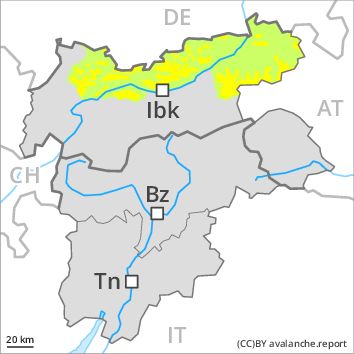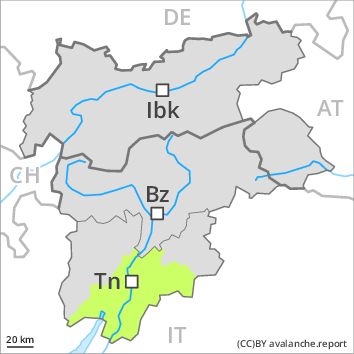Regions
Karwendel Mountains, Brandenberg Alps, Western Kitzbühel Alps, Wilder Kaiser Mountains - Waidring Alps, Eastern Kitzbühel Alps, Grieskogel Mountains, Eastern Lechtal Alps - Ammergau Alps, Mieming Mountains

Danger level
Danger Level 2 - Moderate above the treeline
Danger Level 1 - Low above the treeline
Avalanche Problem
Wind-drifted snow above the treeline, N-NE-E-SE-NW

Fresh wind slabs above the tree line.
The sometimes storm force wind will transport the fresh and old snow. As a consequence of fresh snow and a strong to storm force northwesterly wind, sometimes avalanche prone wind slabs will form from the middle of the day above the tree line. This applies in particular on steep northwest, north and east facing slopes above the tree line as well as adjacent to ridgelines and in gullies and bowls. As the day progresses the previously small wind slabs will increase in size additionally. These can to an increasing extent be released by small loads. Additionally in very isolated cases avalanches can also be released in the old snowpack and reach medium size in particular on very steep shady slopes.
Snowpack
dp 5: snowfall after a long period of cold
dp 6: cold, loose snow and wind
The snowpack will be subject to considerable local variations. In some places relatively hard layers of snow are lying on old snow containing large grains, in particular adjacent to ridgelines as well as on wind-loaded slopes. Faceted weak layers exist in the old snowpack especially in places that are protected from the wind.
5 to 10 cm of snow. will fall until the evening. The sometimes storm force wind will transport the fresh and old snow. This applies in particular on steep northwest, north and east facing slopes above the tree line as well as adjacent to ridgelines and in gullies and bowls. The fresh snow and wind slabs will be deposited on the unfavourable surface of an old snowpack in particular on shady slopes above the tree line.
Tendency
Wednesday: Significant increase in avalanche danger as a consequence of fresh snow and strong wind.
Regions
Sexten Dolomites, Latemar, Southern Adamello, Adamello - Presanella, Northern Brenta - Peller, Southern Brenta, Northern Lagorai, Allgäu Alps, Western Lechtal Alps, Central Lechtal Alps, Val Müstair Alps, Western Verwall Mountains, Langtaufers, Eastern Verwall Mountains, Schnals Ridge, Silvretta, Southern Stubai Alps, Samnaun Mountains, Southern Zillertal Alps and High Tauern, Northern Oetz and Stubai Alps, Saldurn-Mastaun Ridge, Western Tuxer Alps, Texel Mountains, Eastern Tuxer Alps, Sarntal Alps, Western Pfunderer Mountains, Glockturm Range, Maddalene, Eastern Pfunderer Mountains, Durreck Range, Weißkugel Range, Western Rieserferner Mountains, Gurgler Range, Western Deferegger Alps, Central Stubai Alps, Ortler Range, Northern Zillertal Alps, Ulten Valley, Venediger Range, Eastern Nonsberger Alps, Eastern Rieserferner Mountains, Northern Dolomites of Fiemme, Glockner Range, Gröden Dolomites, Primiero - Pale di S. Martino, Eastern Deferegger Alps, Prags Dolomites, Schober Mountains, Lienzer Dolomites, Western Nonsberg Alps, Fassa Valley, Sole, Pejo and Rabbi

Danger level
Danger Level 2 - Moderate above the treeline
Danger Level 1 - Low above the treeline
Avalanche Problem
Wind-drifted snow above the treeline, N-NE-E-SE-NW

Fresh wind slabs require caution.
As a consequence of fresh snow and strong wind the wind slabs will increase in size as the day progresses. The prevalence of avalanche prone locations and likelihood of triggering will increase in the afternoon. The fresh wind slabs can be released by a single winter sport participant in some cases in particular on steep shady slopes. From origins in starting zones at higher altitudes dry slab avalanches are possible, but they will be mostly small. They can be released in the weakly bonded old snow in particular in areas where the snow cover is rather shallow.
Snowpack
dp 5: snowfall after a long period of cold
Over a wide area 5 to 15 cm of snow, and even more in some localities, will fall until the evening. The strong wind will transport the fresh snow. Especially above the tree line sometimes easily released wind slabs will form. The fresh snow and wind slabs will be deposited on a weakly bonded old snowpack in particular on shady slopes. Faceted weak layers exist in the old snowpack especially here.
Tendency
Wednesday: Further increase in avalanche danger in the regions exposed to precipitation.
Regions
Prealps, Cembra Valley, Bondone and Stivo, Vallarsa, Folgaria - Laverone, Southern Lagorai, Ledro Valley, Paganella, Marzola - Valsugana, Pine' - Mocheni Valley

Danger level
Danger Level 1 - Low
Avalanche Problem
Wind-drifted snow above the treeline, N-NE-E-SE-S-SW-W-NW

Fresh wind slabs represent the main danger.
As a consequence of fresh snow and strong wind the wind slabs will increase in size as the day progresses. These can be released by a single winter sport participant in some cases in particular on steep shady slopes. The avalanche prone locations are quite prevalent but are clearly recognisable to the trained eye. Even in moderately steep terrain there is a danger of falling on the hard crust.
Snowpack
Over a wide area up to 10 cm of snow. will fall until the evening above approximately 1000 m. The strong wind will transport the fresh snow. Especially above the tree line sometimes easily released wind slabs will form. The fresh snow and wind slabs will be deposited on a weakly bonded old snowpack in particular on shady slopes. Faceted weak layers exist in the old snowpack especially here.
Tendency
Wednesday: In some localities increase in avalanche danger in particular in the regions exposed to heavier precipitation.



